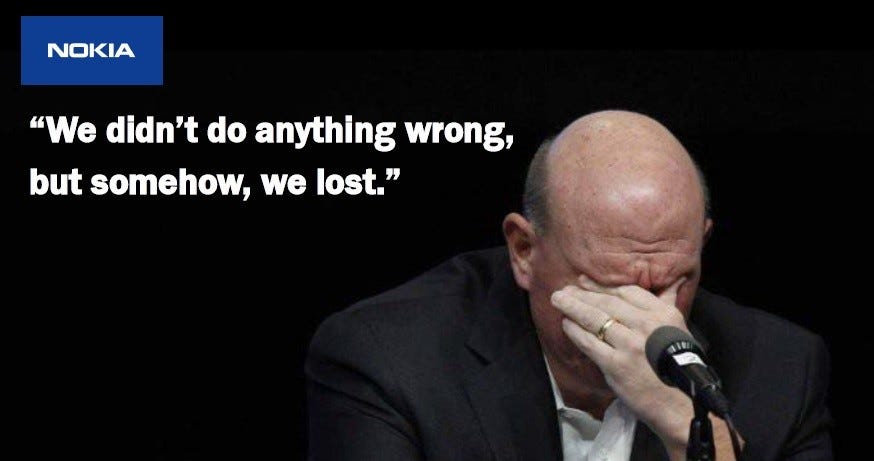Why did Nokia fail and what can you learn from it?
Why did Nokia fail?

This article presents one of Nokia’s reasons for failure and what you can learn to improve your leadership.
A concise timeline of Nokia’s important moments:
- In October 1998, Nokia became the best-selling mobile phone brand in the world;
- Nokia’s operating profit went from $1 billion in 1995 to almost $4 billion by 1999;
- The best-selling mobile phone of all time, the Nokia 1100, was created in 2003;
- In 2007, Apple introduced the iPhone;
- By the end of 2007, half of all smartphones sold in the world were Nokias, while Apple’s iPhone had a mere 5 per cent share of the global market;
- In 2010 Nokia launched the “iPhone killer” but failed to match the competition;
- The quality of Nokia’s high-end phones continues to decline;
- In just six years, the market value of Nokia declined by about 90%;
- Nokia’s decline accelerates by 2011 and is acquired by Microsoft in 2013.
Nokia’s demise from being the world’s best mobile phone company to losing it all by 2013 has become a case study discussed by teachers and students in business management classes.
When explaining Nokia’s fall many observers found three reasons:
- Nokia’s technology was inferior to Apple’s;
- The arrogance among top-level managers;
- Lack of vision.
In order to understand its rapid downfall from its position as a world-dominant and innovative technology organisation, Tim O. Vuori, assistant professor in strategic management at Aalto University and Qui Huy, Professor of Strategy at INSEAD Singapore conducted a qualitative study. The results were published in the 2015 paper Distributed Attention and Shared Emotions in the Innovation Process: How Nokia Lost the Smartphone Battle.
The study consisted of interviewing 76 Nokia top and middle managers, engineers and external experts and conducting in-depth investigations.
Here is what Mr Huy and Mr Vuori found:
- At that time Nokia suffered from organisational fear;
- The organisational fear was grounded in a culture of temperamental leadersand frightened middle managers;
- The middle management was scared oftelling the truth because they feared being fired;
- Top managers were afraid of the external environment and not meeting their quarterly targets;
- Executives were afraid to publicly acknowledge the inferiority of Symbian, Nokia’s operating system;
- They knew it would take several years to develop a better operating system that could compete with Apple’s iOS;
- Top executives were afraid of losing investors, suppliers and customers if they acknowledged their technological inferiority to Apple;
- Top managers intimidated middle managers by accusing them of not being ambitious enough to meet their goals;
- Top management was lied to by middle management who felt telling the truth was useless;
- Top managers lacked technical competence which influenced how they could assess technological limitations during goal setting; by comparison, the top engineers at Apple were all engineers;
- Instead of allocating resources to the achievement of long-term goals such as developing a new operating system, Nokia management decided to develop new phone devices for short-termmarket demands.
The experts’ conclusion regarding why Nokia failed to adapt and compete is this:
Nokia’s ultimate fall can be put down to internal politics. In short, Nokia people weakened Nokia people and thus made the company increasingly vulnerable to competitive forces. When fearpermeated all levels, the lower rungs of the organisation turned inward to protect resources, themselves and their units, giving little away, fearing harm to their personal careers. Top managers failed to motivate the middle managers with their heavy-handed approaches and they were in the dark with what was really going on.
Key takeaways
Nokia’s culture of status has led to an atmosphere of shared fear which influenced how employees were interacting with each other. The human factor was added to economic and structural factors and together they have generated a state of “temporal myopia” that hindered Nokia’s ability to innovate. Employees stated that top managers and directors were no longer abiding by Nokia’s core values of Respect, Challenge, Achievement and Renewal. This study points out the paramount importance of shared emotions among employees and their powerful impact on the company’s competitiveness.
We asked Amalia Sterescu, Leadership Consultant what steps should leaders take to keep themselves connected to their employees and be aware of their emotions and state of mind.
In a world dominated by digital transformation, leaders should understand that operating with the old mindset will not help their companies face customer behaviour changes or new types of competition — more aggressive and more diverse.
- Having the power of constantly challenging the status quo will allow leaders and their organisation to embrace a culture of change;
- Collaborative leadership style will be mandatory, the policy of closed doors will die quickly — innovation process should be encouraged at all levels but for this leaders have to learn again how to properly listen to their customers, partners and employees;
- Before being able to understand their employees’ emotions, leaders will have to become more mindful. Emotional intelligence in action will not be just a competence nice to have — will become mandatory especially when at the decision table leaders will have a mix of generations including Millennials and Z;
- In the end, leaders should master the power of taking responsibilities for bad decisions, failed innovation, lost market share despite the danger of losing their status, role, bonuses. Learning fast from failures or from other companies’ failures will help leaders repair, minimize risks & damages and design better services & products;
- Middle managers will need more courage to challenge the CEO or Sr. Leadership for the benefit of the whole organisation and to accomplish this HR should act as a real business partner and mitigator.
Amalia Sterescu
Microsoft learned from Nokia’s mistakes and changed its culture.
In 2014, Satya Nadella became the current CEO of Microsoft, following Bill Gates and Steve Ballmer.
The most important change that Satya brought to Microsoft was shifting the company’s culture. He says that his job as CEO is to create a culture that focuses on listening, learning, and harnessing individual passions and talents. Satya also placed employer empowerment at the core of Microsoft’s culture.
Company culture is not to be taken lightly. In fact company culture is a major factor that contributes to the company’s development and ability to compete and be successful.
Company culture starts at the top and grows at the bottom. It includes mission, values, environment, ethics, expectations, overall mood, goals etc. But unless the company’s leadership fully embraces them, they are just beautiful but empty words. Leaders must embody the company’s values and be role models for their employees.

Brand Minds is the biggest business conference in Central and Eastern Europe.
OUR MISSION is to create experiences that improve people’s lives by offering access to information, opportunities and sustainable development now and for future generations.



No comments:
Post a Comment